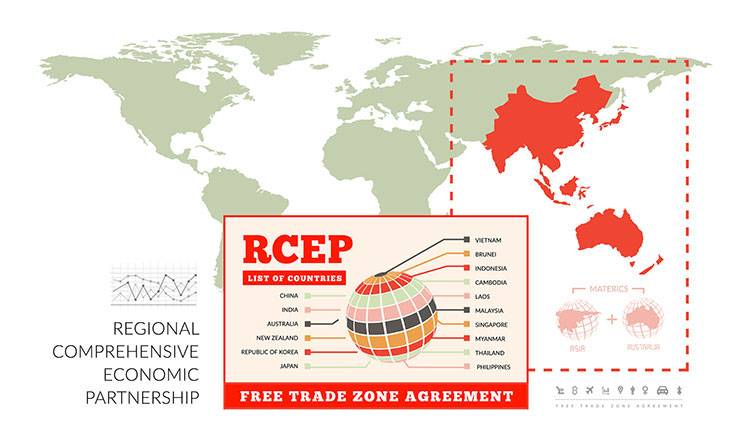‘RCEP gives big boost to Cambodia’s economy’
Xinhua – The RCEP trade deal gives a big boost to Cambodia’s economy, with export to the member countries of the mega-pact up 11 percent in Q1. The top three export destinations are Vietnam, China and Thailand.
Cambodia’s total export to the Regional Comprehensive Economic Partnership (RCEP) member countries amounted to 1.95 billion US dollars in the first quarter of 2022, up 11 percent from 1.75 billion dollars over the same period last year, a Ministry of Commerce’s data showed on Thursday.
During the January-March period this year, Cambodia’s top three export destinations are Vietnam, China and Thailand, the data said, adding that the kingdom shipped products worth 759 million dollars to Vietnam, 322 million dollars to China and 318 million dollars to Thailand.
Penn Sovicheat, Cambodian Ministry of Commerce’s undersecretary of state and spokesman, attributed the export growth to the RCEP free trade agreement, which entered into force on January 1, 2022.
“It’s just the start. The RCEP trade deal will give a big boost to our economy in the long term,” he told Xinhua. “Under this mega-pact, Cambodia is projected to see a year’s export growth at 9.4 percent to 18 percent, which will contribute to the national economic growth from 2 percent to 3.8 percent.”
The regional trade pact comprises 15 Asia-Pacific countries including 10 member states of the Association of Southeast Asian Nations (ASEAN) — Brunei, Cambodia, Indonesia, Laos, Malaysia, Myanmar, the Philippines, Singapore, Thailand and Vietnam — and their five trading partners, namely China, Japan, South Korea, Australia and New Zealand.
It will eliminate as much as 90 percent of the tariffs on goods traded between its signatories over the next 20 years.
“For Cambodia, China is a huge market for us, especially for our potential agricultural produce such as rice, bananas, mangoes, and cassava as well as industrial products, and processing goods,” Sovicheat said.
Senior economist Ky Sereyvath, director-general of the Institute of China Studies at the Royal Academy of Cambodia, said the RCEP trade deal has provided Cambodia bigger market access and a great opportunity to diversify its exports.
“This pact is also one of the key factors for attracting more international investors, especially from China, to Cambodia,” he told Xinhua. “It will help Cambodia quicken its economic recovery from the COVID-19 pandemic.”
Sereyvath said that through the RCEP trade pact, Cambodia could be a hub-and-spoke model to distribute goods from China to the ASEAN region.
Being the world’s largest trade bloc, the RCEP trade deal has a combined Gross Domestic Product (GDP) of 26.2 trillion US dollars, representing around 30 percent of global GDP, 28 percent of global trade, and 32.5 percent of global investment.
“The pact has served as a catalyst for regional and global economic growth and undoubtedly, all participating countries will benefit from it at different levels,” Sereyvath said. “I believe that it will become a new center of gravity for global trade in the future.”
Thong Mengdavid, a research fellow at the Phnom Penh-based Asian Vision Institute, said the pact offered an opportunity for regional countries to defend trade liberalization and promote economic integration, which are key to the post-COVID-19 recovery.
“The successful story of RCEP serves as a role model for multilateralism and is a hope for cross-regional economic cooperation and connectivity in the post-pandemic era,” he said.


 English
English




